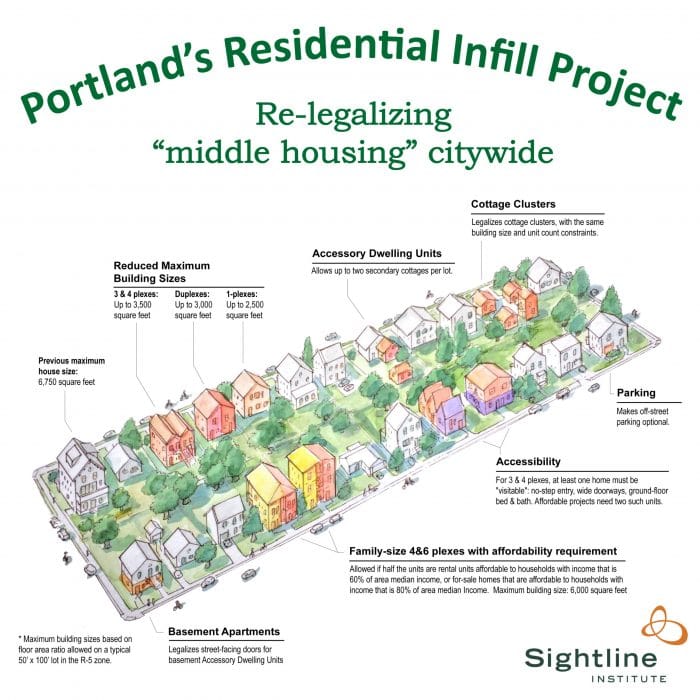Starting 2021, a Six Plex can be built next to any Portland Home.

Travel back in time to Portland 150 years ago, and you’d see a housing mix that is different from today’s suburban, single-family-home-dominated neighborhoods. There were garden houses, rowhouses, courtyard apartments and cottages. Density was higher, and nobody needed parking because they used the Portland streetcar to get around (plus cars hadn’t been invented).
This vision has inspired a piece of legislation five years in the making: the Residential Infill Project. The goal of RIP, as it is known around Portland, is to reconstruct that higher-density time in Portland’s housing mix, in a contemporary way. The idea isn’t to strip away all zoning rules and create a housing free-for-all. In fact, RIP received a record-setting 15,000 public comments as it moved through the legislative channels, and the result is a 300-page book of zoning codes that is being widely hailed as a housing solution that works for everyone — homeowners, home buyers, and real estate developers.
In August 2020, Portland city council gave the final approval to the RIP ordinance, and the new rules go into effect in August 2021. In this blog post, we take a closer look at what is and isn’t allowed under RIP, who it will effect, and how the real estate market might be impacted.
Why RIP, Why Now?
Portland, like most major US cities, has a major need for more housing:
- For every 10 new households formed in Oregon since 2010, only seven new units of housing have been built, according to the Portland Tribune.
- Affordable housing is especially scarce: Metro estimates that there’s a shortfall of about 48,000 housing units, which is pushing minimum-wage earners out of the city.
- Overall, the growth forecast is for 100,000 more households forming in the Portland metro area by 2035. Portland Bureau of Planning and Sustainability estimates that RIP will fill about a quarter of the housing need for those households.
- Infill brings new households in to the urbanized area of Portland, where jobs, transit, healthcare and other amenities are readily available.
- In addition, the text of the RIP ordinance acknowledges that racially discriminatory decisions were made over the city’s history that resulted in racial disparities in homeownership rates and wealth attainment in Portland. Infill can help rectify this by creating more affordable housing options, and more housing units in historically Black neighborhoods.
A Closer Look at the New Portland Zoning Rules
Portland’s Residential Infill Project was recently called the “best low-density zoning reform in US history” by the Sightline Institute, a progressive think tank. Because single-family housing is typically low density, it’s also been called “the end of single-family zoning”.
That startling headline is true, but the RIP doesn’t ban single-family homes. It does open up zoning restrictions to allow multi-family units to be built in neighborhoods that were previously single-family only. It also decreases the maximum allowable square footage for new construction. Finally, it requires a certain number of units to be affordable to low-income Portlanders.
Up to Six Units per Lot in Portland – New Zoning Law
Under the old zoning rules, only one home could be built on a lot, with one Accessory Dwelling Unit, either attached or detached (for much of the city’s residential zoning areas, depending on lot size). RIP’s objective is to allow the “missing middle” of housing to be built — multiple homes sharing single-family lots, accommodating smaller households, which are on the rise in Portland. The new building configurations allowed under RIP are:
- Up to four attached units, such as a duplex or row house. The total square footage of the structure can’t exceed 3,500 square feet.
- Attached units in four- or six-plexes can also be built, with square footage up to 6,000 square feet, if half the units are affordable housing. Honestly, that is an enormous building in some of these smaller Portland city lots.
- Up to four smaller detached units in “cottage clusters” can be built on one lot.
- An existing single-family home can have up to two Accessory Dwelling Units. Click here for our 2021 Portland ADU Guide.

Portland Residential Infill Project Map
The new rules will cover nearly 100% of Portland, with few exceptions. Check out the residential infill project map here, you can see how it will affect any Portland address.
Smaller Homes
Another major rule change included in the RIP is to decrease the maximum allowed square footage for a single-family home, from 6,750 square feet to 2,500 square feet max. That sounds like a big drop, but the average square footage for a new home in Oregon is just 1,780. And most Portland homes were built between 1940-60, when home sizes averaged between 900 and 1200 square feet! For more about home sizes and Portland real estate, check out our blog post here.
Other changes created by RIP
- Visitability. For lots with more than two units, including homes with two ADUs, at least one unit must be “visitable”. This means that it must have certain accessibility features needed for a person using a walker or a wheelchair. Visitability is not the same as being fully handicapped accessible, because only has requirements for an accessible entry and ground-level bathroom.
- Parking requirements lifted. Units can be developed without creating parking on-site. This will put more pressure on street parking, but the city hopes it will encourage use of alternative modes of transportation.
- Allows development on narrow lots. Previously, code restrictions kept narrow lots from having homes put on them, but now they will be allowed. In addition, large lots will be required to have at least two housing units.
- Removes basement ADU size limitations. For homeowners who wish to convert their basement into an ADU, there’s no longer a need to artificially constrict the size of larger basements. In addition, basement ADUs can now have an entry facing the same direction as the main entry to the house.
RIP and the Portland Real Estate Market
Will developers jump on the opportunities to create new housing types in Portland? If they do, it won’t be overnight. First lots must become available, and if there’s an existing home on the lot that needs to be torn down, demolition is a costly endeavor.
However, we do expect Portland homeowners to add more ADUs, which don’t require anything to be torn down and can pay for themselves within a decade. This is a fantastic option to provide more housing and to create wealth for families and individual homeowners.
Because no city has ever passed an ordinance quite like RIP (even Minneapolis’ headline-grabbing policies don’t go as far to encourage infill), nobody can quite say what will happen next. Maybe infill, combined with new development on the outer edges of the metro area and slowing population growth, will finally take some of the pressure off the Portland real estate housing market. On the other hand, in a city where home values have climbed every year since 2012, it will take a lot to cool things down.
Do you need a local expert on the Portland real estate market to answer your questions? Our top 1% Portland seller’s agent and buyer’s agents are just a phone call or email away.


